Ellipse
In mathematics, an ellipse is a plane curve surrounding two focal points, such that for all points on the curve, the sum of the two distances to the focal points is a constant. As such, it generalizes a circle, which is the special type of ellipse in which the two focal points are the same. The elongation of an ellipse is measured by its eccentricity e, a number ranging from e = 0 (the limiting case of a circle) to e = 1 (the limiting case of infinite elongation, no longer an ellipse but a parabola).

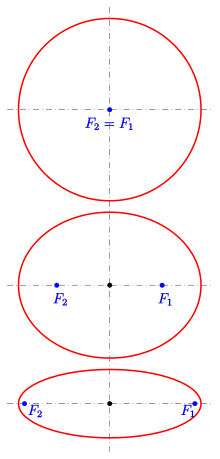
Analytically, the equation of a standard ellipse centered at the origin with width 2a and height 2b is:
Assuming a ≥ b, the foci are (±c, 0) for . The standard parametric equation is:
Ellipses are the closed type of conic section: a plane curve tracing the intersection of a cone with a plane (see figure). Ellipses have many similarities with the other two forms of conic sections, parabolas and hyperbolas, both of which are open and unbounded. An angled cross section of a cylinder is also an ellipse.
An ellipse may also be defined in terms of one focal point and a line outside the ellipse called the directrix: for all points on the ellipse, the ratio between the distance to the focus and the distance to the directrix is a constant. This constant ratio is the above-mentioned eccentricity:
- .
Ellipses are common in physics, astronomy and engineering. For example, the orbit of each planet in the solar system is approximately an ellipse with the Sun at one focus point (more precisely, the focus is the barycenter of the Sun–planet pair). The same is true for moons orbiting planets and all other systems of two astronomical bodies. The shapes of planets and stars are often well described by ellipsoids. A circle viewed from a side angle looks like an ellipse: that is, the ellipse is the image of a circle under parallel or perspective projection. The ellipse is also the simplest Lissajous figure formed when the horizontal and vertical motions are sinusoids with the same frequency: a similar effect leads to elliptical polarization of light in optics.
The name, ἔλλειψις (élleipsis, "omission"), was given by Apollonius of Perga in his Conics.
Definition as locus of points
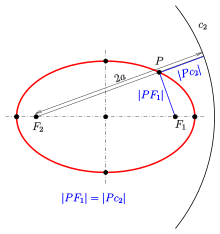
An ellipse can be defined geometrically as a set or locus of points in the Euclidean plane:
- Given two fixed points called the foci and a distance which is greater than the distance between the foci, the ellipse is the set of points such that the sum of the distances is equal to :
The midpoint of the line segment joining the foci is called the center of the ellipse. The line through the foci is called the major axis, and the line perpendicular to it through the center is the minor axis. The major axis intersects the ellipse at the vertex points , which have distance to the center. The distance of the foci to the center is called the focal distance or linear eccentricity. The quotient is the eccentricity.
The case yields a circle and is included as a special type of ellipse.
The equation can be viewed in a different way (see figure):
- If is the circle with midpoint and radius , then the distance of a point to the circle equals the distance to the focus :
is called the circular directrix (related to focus ) of the ellipse.[1][2] This property should not be confused with the definition of an ellipse using a directrix line below.
Using Dandelin spheres, one can prove that any plane section of a cone with a plane is an ellipse, assuming the plane does not contain the apex and has slope less than that of the lines on the cone.
In Cartesian coordinates

- a: semi-major axis,
- b: semi-minor axis,
- c: linear eccentricity,
- p: semi-latus rectum (usually ).
Standard equation
The standard form of an ellipse in Cartesian coordinates assumes that the origin is the center of the ellipse, the x-axis is the major axis, and:
- the foci are the points ,
- the vertices are .
For an arbitrary point the distance to the focus is and to the other focus . Hence the point is on the ellipse whenever:
Removing the radicals by suitable squarings and using produces the standard equation of the ellipse:
or, solved for y:
The width and height parameters are called the semi-major and semi-minor axes. The top and bottom points are the co-vertices. The distances from a point on the ellipse to the left and right foci are and .
It follows from the equation that the ellipse is symmetric with respect to the coordinate axes and hence with respect to the origin.
Parameters
Semi-major and semi-minor axes
Throughout this article is the semi-major axis, i.e. In general the canonical ellipse equation may have (and hence the ellipse would be taller than it is wide); in this form the semi-major axis would be . This form can be converted to the standard form by transposing the variable names and and the parameter names and
Linear eccentricity
This is the distance from the center to a focus: .
Eccentricity
The eccentricity can be expressed as:
- ,
assuming An ellipse with equal axes () has zero eccentricity, and is a circle.
Semi-latus rectum
The length of the chord through one focus, perpendicular to the major axis, is called the latus rectum. One half of it is the semi-latus rectum . A calculation shows:
The semi-latus rectum is equal to the radius of curvature at the vertices (see section curvature).
Tangent
An arbitrary line intersects an ellipse at 0, 1, or 2 points, respectively called an exterior line, tangent and secant. Through any point of an ellipse there is a unique tangent. The tangent at a point of the ellipse has the coordinate equation:
A vector parametric equation of the tangent is:
- with
Proof: Let be a point on an ellipse and be the equation of any line containing . Inserting the line's equation into the ellipse equation and respecting yields:
- There are then cases:
- Then line and the ellipse have only point in common, and is a tangent. The tangent direction has perpendicular vector , so the tangent line has equation for some . Because is on the tangent and the ellipse, one obtains .
- Then line has a second point in common with the ellipse, and is a secant.
Using (1) one finds that is a tangent vector at point , which proves the vector equation.
If and are two points of the ellipse such that , then the points lie on two conjugate diameters (see below). (If , the ellipse is a circle and "conjugate" means "orthogonal".)
Shifted ellipse
If the standard ellipse is shifted to have center , its equation is
The axes are still parallel to the x- and y-axes.
General ellipse
In analytic geometry, the ellipse is defined as a quadric: the set of points of the Cartesian plane that, in non-degenerate cases, satisfy the implicit equation[4][5]
provided
To distinguish the degenerate cases from the non-degenerate case, let ∆ be the determinant
Then the ellipse is a non-degenerate real ellipse if and only if C∆ < 0. If C∆ > 0, we have an imaginary ellipse, and if ∆ = 0, we have a point ellipse.[6]:p.63
The general equation's coefficients can be obtained from known semi-major axis , semi-minor axis , center coordinates , and rotation angle (the angle from the positive horizontal axis to the ellipse's major axis) using the formulae:
These expressions can be derived from the canonical equation by an affine transformation of the coordinates :
Conversely, the canonical form parameters can be obtained from the general form coefficients by the equations:
Parametric representation

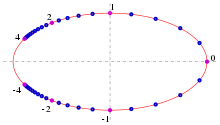
Standard parametric representation
Using trigonometric functions, a parametric representation of the standard ellipse is:
The parameter t (called the eccentric anomaly in astronomy) is not the angle of with the x-axis, but has a geometric meaning due to Philippe de La Hire (see Drawing ellipses below).[7]
Rational representation
With the substitution and trigonometric formulae one obtains
and the rational parametric equation of an ellipse
which covers any point of the ellipse except the left vertex .
For this formula represents the right upper quarter of the ellipse moving counter-clockwise with increasing The left vertex is the limit
Rational representations of conic sections are commonly used in Computer Aided Design (see Bezier curve).
Tangent slope as parameter
A parametric representation, which uses the slope of the tangent at a point of the ellipse can be obtained from the derivative of the standard representation :
With help of trigonometric formulae one obtains:
Replacing and of the standard representation yields:
Here is the slope of the tangent at the corresponding ellipse point, is the upper and the lower half of the ellipse. The vertices, having vertical tangents, are not covered by the representation.
The equation of the tangent at point has the form . The still unknown can be determined by inserting the coordinates of the corresponding ellipse point :
This description of the tangents of an ellipse is an essential tool for the determination of the orthoptic of an ellipse. The orthoptic article contains another proof, without differential calculus and trigonometric formulae.
General ellipse
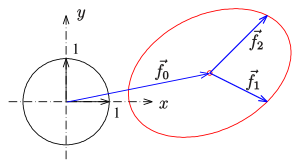
Another definition of an ellipse uses affine transformations:
- Any ellipse is an affine image of the unit circle with equation .
- parametric representation
An affine transformation of the Euclidean plane has the form , where is a regular matrix (with non-zero determinant) and is an arbitrary vector. If are the column vectors of the matrix , the unit circle , , is mapped onto the ellipse:
Here is the center and are the directions of two conjugate diameters, in general not perpendicular.
- vertices
The four vertices of the ellipse are , for a parameter defined by:
(If , then .) This is derived as follows. The tangent vector at point is:
At a vertex parameter , the tangent is perpendicular to the major/minor axes, so:
Expanding and applying the identities gives the equation for .
- implicit representation
Solving the parametric representation for by Cramer's rule and using , one gets the implicit representation
- .
- ellipse in space
The definition of an ellipse in this section gives a parametric representation of an arbitrary ellipse, even in space, if one allows to be vectors in space.
Polar forms
Polar form relative to center
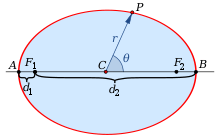
In polar coordinates, with the origin at the center of the ellipse and with the angular coordinate measured from the major axis, the ellipse's equation is[6]:p. 75
Polar form relative to focus
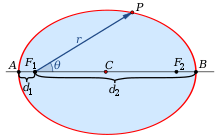
If instead we use polar coordinates with the origin at one focus, with the angular coordinate still measured from the major axis, the ellipse's equation is
where the sign in the denominator is negative if the reference direction points towards the center (as illustrated on the right), and positive if that direction points away from the center.
In the slightly more general case of an ellipse with one focus at the origin and the other focus at angular coordinate , the polar form is
The angle in these formulas is called the true anomaly of the point. The numerator of these formulas is the semi-latus rectum .
Eccentricity and the directrix property

Each of the two lines parallel to the minor axis, and at a distance of from it, is called a directrix of the ellipse (see diagram).
- For an arbitrary point of the ellipse, the quotient of the distance to one focus and to the corresponding directrix (see diagram) is equal to the eccentricity:
The proof for the pair follows from the fact that and satisfy the equation
The second case is proven analogously.
The converse is also true and can be used to define an ellipse (in a manner similar to the definition of a parabola):
- For any point (focus), any line (directrix) not through , and any real number with the ellipse is the locus of points for which the quotient of the distances to the point and to the line is that is:
The choice , which is the eccentricity of a circle, is not allowed in this context. One may consider the directrix of a circle to be the line at infinity.
(The choice yields a parabola, and if , a hyperbola.)
- Proof
Let , and assume is a point on the curve. The directrix has equation . With , the relation produces the equations
- and
The substitution yields
This is the equation of an ellipse (), or a parabola (), or a hyperbola (). All of these non-degenerate conics have, in common, the origin as a vertex (see diagram).
If , introduce new parameters so that , and then the equation above becomes
which is the equation of an ellipse with center , the x-axis as major axis, and the major/minor semi axis .
- General ellipse
If the focus is and the directrix , one obtains the equation
(The right side of the equation uses the Hesse normal form of a line to calculate the distance .)
Focus-to-focus reflection property

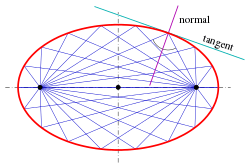
An ellipse possesses the following property:
- The normal at a point bisects the angle between the lines .
- Proof
Because the tangent is perpendicular to the normal, the statement is true for the tangent and the supplementary angle of the angle between the lines to the foci (see diagram), too.
Let be the point on the line with the distance to the focus , is the semi-major axis of the ellipse. Let line be the bisector of the supplementary angle to the angle between the lines . In order to prove that is the tangent line at point , one checks that any point on line which is different from cannot be on the ellipse. Hence has only point in common with the ellipse and is, therefore, the tangent at point .
From the diagram and the triangle inequality one recognizes that holds, which means: . But if is a point of the ellipse, the sum should be .
- Application
The rays from one focus are reflected by the ellipse to the second focus. This property has optical and acoustic applications similar to the reflective property of a parabola (see whispering gallery).
Conjugate diameters

A circle has the following property:
- The midpoints of parallel chords lie on a diameter.
An affine transformation preserves parallelism and midpoints of line segments, so this property is true for any ellipse. (Note that the parallel chords and the diameter are no longer orthogonal.)
- Definition
Two diameters of an ellipse are conjugate if the midpoints of chords parallel to lie on
From the diagram one finds:
- Two diameters of an ellipse are conjugate whenever the tangents at and are parallel to .
Conjugate diameters in an ellipse generalize orthogonal diameters in a circle.
In the parametric equation for a general ellipse given above,
any pair of points belong to a diameter, and the pair belong to its conjugate diameter.
Theorem of Apollonios on conjugate diameters
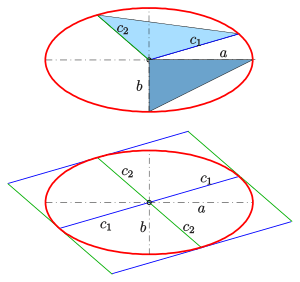
For an ellipse with semi-axes the following is true:
- Let and be halves of two conjugate diameters (see diagram) then
- ,
- the triangle formed by has the constant area
- the parallelogram of tangents adjacent to the given conjugate diameters has the
- Proof
Let the ellipse be in the canonical form with parametric equation
- .
The two points are on conjugate diameters (see previous section). From trigonometric formulae one obtains and
The area of the triangle generated by is
and from the diagram it can be seen that the area of the parallelogram is 8 times that of . Hence
Orthogonal tangents

For the ellipse the intersection points of orthogonal tangents lie on the circle .
This circle is called orthoptic or director circle of the ellipse (not to be confused with the circular directrix defined above).
Drawing ellipses
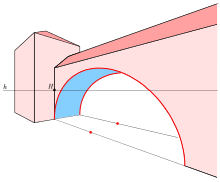
Ellipses appear in descriptive geometry as images (parallel or central projection) of circles. There exist various tools to draw an ellipse. Computers provide the fastest and most accurate method for drawing an ellipse. However, technical tools (ellipsographs) to draw an ellipse without a computer exist. The principle of ellipsographs were known to Greek mathematicians such as Archimedes and Proklos.
If there is no ellipsograph available, one can draw an ellipse using an approximation by the four osculating circles at the vertices.
For any method described below, knowledge of the axes and the semi-axes is necessary (or equivalently: the foci and the semi-major axis). If this presumption is not fulfilled one has to know at least two conjugate diameters. With help of Rytz's construction the axes and semi-axes can be retrieved.
de La Hire's point construction
The following construction of single points of an ellipse is due to de La Hire.[8] It is based on the standard parametric representation of an ellipse:
- Draw the two circles centered at the center of the ellipse with radii and the axes of the ellipse.
- Draw a line through the center, which intersects the two circles at point and , respectively.
- Draw a line through that is parallel to the minor axis and a line through that is parallel to the major axis. These lines meet at an ellipse point (see diagram).
- Repeat steps (2) and (3) with different lines through the center.
 de La Hire's method
de La Hire's method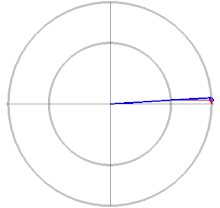 Animation of the method
Animation of the method

Pins-and-string method
The characterization of an ellipse as the locus of points so that sum of the distances to the foci is constant leads to a method of drawing one using two drawing pins, a length of string, and a pencil. In this method, pins are pushed into the paper at two points, which become the ellipse's foci. A string tied at each end to the two pins and the tip of a pencil pulls the loop taut to form a triangle. The tip of the pencil then traces an ellipse if it is moved while keeping the string taut. Using two pegs and a rope, gardeners use this procedure to outline an elliptical flower bed—thus it is called the gardener's ellipse.
A similar method for drawing confocal ellipses with a closed string is due to the Irish bishop Charles Graves.
Paper strip methods
The two following methods rely on the parametric representation (see section parametric representation, above):
This representation can be modeled technically by two simple methods. In both cases center, the axes and semi axes have to be known.
- Method 1
The first method starts with
- a strip of paper of length .
The point, where the semi axes meet is marked by . If the strip slides with both ends on the axes of the desired ellipse, then point P traces the ellipse. For the proof one shows that point has the parametric representation , where parameter is the angle of the slope of the paper strip.
A technical realization of the motion of the paper strip can be achieved by a Tusi couple (see animation). The device is able to draw any ellipse with a fixed sum , which is the radius of the large circle. This restriction may be a disadvantage in real life. More flexible is the second paper strip method.
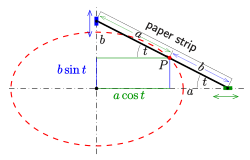 Ellipse construction: paper strip method 1
Ellipse construction: paper strip method 1 Ellipses with Tusi couple. Two examples: red and cyan.
Ellipses with Tusi couple. Two examples: red and cyan.
A variation of the paper strip method 1 uses the observation that the midpoint of the paper strip is moving on the circle with center (of the ellipse) and radius . Hence, the paperstrip can be cut at point into halves, connected again by a joint at and the sliding end fixed at the center (see diagram). After this operation the movement of the unchanged half of the paperstrip is unchanged.[9] This variation requires only one sliding shoe.
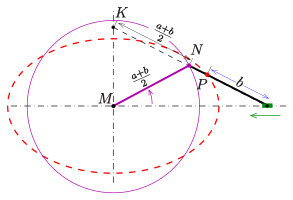 Variation of the paper strip method 1
Variation of the paper strip method 1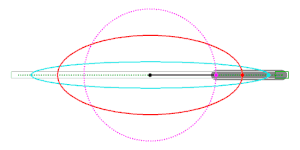 Animation of the variation of the paper strip method 1
Animation of the variation of the paper strip method 1

- Method 2
The second method starts with
- a strip of paper of length .
One marks the point, which divides the strip into two substrips of length and . The strip is positioned onto the axes as described in the diagram. Then the free end of the strip traces an ellipse, while the strip is moved. For the proof, one recognizes that the tracing point can be described parametrically by , where parameter is the angle of slope of the paper strip.
This method is the base for several ellipsographs (see section below).
Similar to the variation of the paper strip method 1 a variation of the paper strip method 2 can be established (see diagram) by cutting the part between the axes into halves.
 Trammel of Archimedes (principle)
Trammel of Archimedes (principle) Ellipsograph due to Benjamin Bramer
Ellipsograph due to Benjamin Bramer Variation of the paper strip method 2
Variation of the paper strip method 2
Most ellipsograph drafting instruments are based on the second paperstrip method.
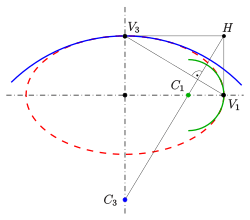
Approximation by osculating circles
From Metric properties below, one obtains:
- The radius of curvature at the vertices is:
- The radius of curvature at the co-vertices is:
The diagram shows an easy way to find the centers of curvature at vertex and co-vertex , respectively:
- mark the auxiliary point and draw the line segment
- draw the line through , which is perpendicular to the line
- the intersection points of this line with the axes are the centers of the osculating circles.
(proof: simple calculation.)
The centers for the remaining vertices are found by symmetry.
With help of a French curve one draws a curve, which has smooth contact to the osculating circles.
Steiner generation

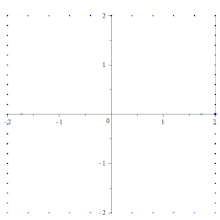
The following method to construct single points of an ellipse relies on the Steiner generation of a conic section:
- Given two pencils of lines at two points (all lines containing and , respectively) and a projective but not perspective mapping of onto , then the intersection points of corresponding lines form a non-degenerate projective conic section.
For the generation of points of the ellipse one uses the pencils at the vertices . Let be an upper co-vertex of the ellipse and .
is the center of the rectangle . The side of the rectangle is divided into n equal spaced line segments and this division is projected parallel with the diagonal as direction onto the line segment and assign the division as shown in the diagram. The parallel projection together with the reverse of the orientation is part of the projective mapping between the pencils at and needed. The intersection points of any two related lines and are points of the uniquely defined ellipse. With help of the points the points of the second quarter of the ellipse can be determined. Analogously one obtains the points of the lower half of the ellipse.
Steiner generation can also be defined for hyperbolas and parabolas. It is sometimes called a parallelogram method because one can use other points rather than the vertices, which starts with a parallelogram instead of a rectangle.
As hypotrochoid
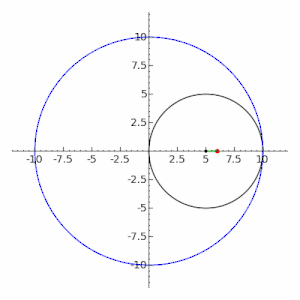
The ellipse is a special case of the hypotrochoid when R = 2r, as shown in the adjacent image. The special case of a moving circle with radius inside a circle with radius is called a Tusi couple.
Inscribed angles and three-point form
Circles

A circle with equation is uniquely determined by three points not on a line. A simple way to determine the parameters uses the inscribed angle theorem for circles:
- For four points (see diagram) the following statement is true:
- The four points are on a circle if and only if the angles at and are equal.
Usually one measures inscribed angles by a degree or radian θ, but here the following measurement is more convenient:
- In order to measure the angle between two lines with equations one uses the quotient:
Inscribed angle theorem for circles
For four points no three of them on a line, we have the following (see diagram):
- The four points are on a circle, if and only if the angles at and are equal. In terms of the angle measurement above, this means:
At first the measure is available only for chords not parallel to the y-axis, but the final formula works for any chord.
Three-point form of circle equation
- As a consequence, one obtains an equation for the circle determined by three non-colinear points :
For example, for the three-point equation is:
- , which can be rearranged to
Using vectors, dot products and determinants this formula can be arranged more clearly, letting :
The center of the circle satisfies:
The radius is the distance between any of the three points and the center.
Ellipses
This section, we consider the family of ellipses defined by equations with a fixed eccentricity e. It is convenient to use the parameter:
and to write the ellipse equation as:
where q is fixed and vary over the real numbers. (Such ellipses have their axes parallel to the coordinate axes: if , the major axis is parallel to the x-axis; if , it is parallel to the y-axis.)

Like a circle, such an ellipse is determined by three points not on a line.
For this family of ellipses, one introduces the following q-analog angle measure, which is not a function of the usual angle measure θ:[10][11]
- In order to measure an angle between two lines with equations one uses the quotient:
Inscribed angle theorem for ellipses
- Given four points , no three of them on a line (see diagram).
- The four points are on an ellipse with equation if and only if the angles at and are equal in the sense of the measurement above—that is, if
At first the measure is available only for chords which are not parallel to the y-axis. But the final formula works for any chord. The proof follows from a straightforward calculation. For the direction of proof given that the points are on an ellipse, one can assume that the center of the ellipse is the origin.
Three-point form of ellipse equation
- A consequence, one obtains an equation for the ellipse determined by three non-colinear points :
For example, for and one obtains the three-point form
- and after conversion
Analogously to the circle case, the equation can be written more clearly using vectors:
where is the modified dot product
Pole-polar relation

Any ellipse can be described in a suitable coordinate system by an equation . The equation of the tangent at a point of the ellipse is If one allows point to be an arbitrary point different from the origin, then
- point is mapped onto the line , not through the center of the ellipse.
This relation between points and lines is a bijection.
The inverse function maps
- line onto the point and
- line onto the point
Such a relation between points and lines generated by a conic is called pole-polar relation or polarity. The pole is the point, the polar the line.
By calculation one can confirm the following properties of the pole-polar relation of the ellipse:
- For a point (pole) on the ellipse the polar is the tangent at this point (see diagram: ).
- For a pole outside the ellipse the intersection points of its polar with the ellipse are the tangency points of the two tangents passing (see diagram: ).
- For a point within the ellipse the polar has no point with the ellipse in common. (see diagram: ).
- The intersection point of two polars is the pole of the line through their poles.
- The foci and respectively and the directrices and respectively belong to pairs of pole and polar.
Pole-polar relations exist for hyperbolas and parabolas, too.
Metric properties
All metric properties given below refer to an ellipse with equation .
Area
The area enclosed by an ellipse is:
where and are the lengths of the semi-major and semi-minor axes, respectively. The area formula is intuitive: start with a circle of radius (so its area is ) and stretch it by a factor to make an ellipse. This scales the area by the same factor: It is also easy to rigorously prove the area formula using integration as follows. Equation (1) can be rewritten as For this curve is the top half of the ellipse. So twice the integral of over the interval will be the area of the ellipse:
The second integral is the area of a circle of radius that is, So
An ellipse defined implicitly by has area
The area can also be expressed in terms of eccentricity and the length of the semi-major axis as (obtained by solving for flattening, then computing the semi-minor axis).
Circumference

The circumference of an ellipse is:
where again is the length of the semi-major axis, is the eccentricity, and the function is the complete elliptic integral of the second kind,
The circumference of the ellipse may be evaluated in terms of using Gauss's arithmetic-geometric mean;[12] this is a quadratically converging iterative method.[13]
The exact infinite series is:
where is the double factorial. This series converges, but by expanding in terms of James Ivory[14] and Bessel[15] derived an expression that converges much more rapidly:
Srinivasa Ramanujan gives two close approximations for the circumference in §16 of "Modular Equations and Approximations to ";[16] they are
and
The errors in these approximations, which were obtained empirically, are of order and respectively.
More generally, the arc length of a portion of the circumference, as a function of the angle subtended (or x-coordinates of any two points on the upper half of the ellipse), is given by an incomplete elliptic integral. The upper half of an ellipse is parameterized by
Then the arc length from to is:
This is equivalent to
where is the incomplete elliptic integral of the second kind with parameter
The inverse function, the angle subtended as a function of the arc length, is given by a certain elliptic function.
Some lower and upper bounds on the circumference of the canonical ellipse with are[17]
Here the upper bound is the circumference of a circumscribed concentric circle passing through the endpoints of the ellipse's major axis, and the lower bound is the perimeter of an inscribed rhombus with vertices at the endpoints of the major and the minor axes.
Curvature
The curvature is given by radius of curvature at point :
Radius of curvature at the two vertices and the centers of curvature:
Radius of curvature at the two co-vertices and the centers of curvature:
In triangle geometry
Ellipses appear in triangle geometry as
- Steiner ellipse: ellipse through the vertices of the triangle with center at the centroid,
- inellipses: ellipses which touch the sides of a triangle. Special cases are the Steiner inellipse and the Mandart inellipse.
As plane sections of quadrics
Ellipses appear as plane sections of the following quadrics:
 Ellipsoid
Ellipsoid Elliptic cone
Elliptic cone Elliptic cylinder
Elliptic cylinder Hyperboloid of one sheet
Hyperboloid of one sheet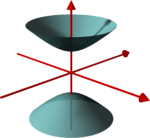 Hyperboloid of two sheets
Hyperboloid of two sheets
Applications
Physics
Elliptical reflectors and acoustics
If the water's surface is disturbed at one focus of an elliptical water tank, the circular waves of that disturbance, after reflecting off the walls, converge simultaneously to a single point: the second focus. This is a consequence of the total travel length being the same along any wall-bouncing path between the two foci.
Similarly, if a light source is placed at one focus of an elliptic mirror, all light rays on the plane of the ellipse are reflected to the second focus. Since no other smooth curve has such a property, it can be used as an alternative definition of an ellipse. (In the special case of a circle with a source at its center all light would be reflected back to the center.) If the ellipse is rotated along its major axis to produce an ellipsoidal mirror (specifically, a prolate spheroid), this property holds for all rays out of the source. Alternatively, a cylindrical mirror with elliptical cross-section can be used to focus light from a linear fluorescent lamp along a line of the paper; such mirrors are used in some document scanners.
Sound waves are reflected in a similar way, so in a large elliptical room a person standing at one focus can hear a person standing at the other focus remarkably well. The effect is even more evident under a vaulted roof shaped as a section of a prolate spheroid. Such a room is called a whisper chamber. The same effect can be demonstrated with two reflectors shaped like the end caps of such a spheroid, placed facing each other at the proper distance. Examples are the National Statuary Hall at the United States Capitol (where John Quincy Adams is said to have used this property for eavesdropping on political matters); the Mormon Tabernacle at Temple Square in Salt Lake City, Utah; at an exhibit on sound at the Museum of Science and Industry in Chicago; in front of the University of Illinois at Urbana–Champaign Foellinger Auditorium; and also at a side chamber of the Palace of Charles V, in the Alhambra.
Planetary orbits
In the 17th century, Johannes Kepler discovered that the orbits along which the planets travel around the Sun are ellipses with the Sun [approximately] at one focus, in his first law of planetary motion. Later, Isaac Newton explained this as a corollary of his law of universal gravitation.
More generally, in the gravitational two-body problem, if the two bodies are bound to each other (that is, the total energy is negative), their orbits are similar ellipses with the common barycenter being one of the foci of each ellipse. The other focus of either ellipse has no known physical significance. The orbit of either body in the reference frame of the other is also an ellipse, with the other body at the same focus.
Keplerian elliptical orbits are the result of any radially directed attraction force whose strength is inversely proportional to the square of the distance. Thus, in principle, the motion of two oppositely charged particles in empty space would also be an ellipse. (However, this conclusion ignores losses due to electromagnetic radiation and quantum effects, which become significant when the particles are moving at high speed.)
For elliptical orbits, useful relations involving the eccentricity are:
where
- is the radius at apoapsis (the farthest distance)
- is the radius at periapsis (the closest distance)
- is the length of the semi-major axis
Also, in terms of and , the semi-major axis is their arithmetic mean, the semi-minor axis is their geometric mean, and the semi-latus rectum is their harmonic mean. In other words,
- .
Harmonic oscillators
The general solution for a harmonic oscillator in two or more dimensions is also an ellipse. Such is the case, for instance, of a long pendulum that is free to move in two dimensions; of a mass attached to a fixed point by a perfectly elastic spring; or of any object that moves under influence of an attractive force that is directly proportional to its distance from a fixed attractor. Unlike Keplerian orbits, however, these "harmonic orbits" have the center of attraction at the geometric center of the ellipse, and have fairly simple equations of motion.
Phase visualization
In electronics, the relative phase of two sinusoidal signals can be compared by feeding them to the vertical and horizontal inputs of an oscilloscope. If the Lissajous figure display is an ellipse, rather than a straight line, the two signals are out of phase.
Elliptical gears
Two non-circular gears with the same elliptical outline, each pivoting around one focus and positioned at the proper angle, turn smoothly while maintaining contact at all times. Alternatively, they can be connected by a link chain or timing belt, or in the case of a bicycle the main chainring may be elliptical, or an ovoid similar to an ellipse in form. Such elliptical gears may be used in mechanical equipment to produce variable angular speed or torque from a constant rotation of the driving axle, or in the case of a bicycle to allow a varying crank rotation speed with inversely varying mechanical advantage.
Elliptical bicycle gears make it easier for the chain to slide off the cog when changing gears.[18]
An example gear application would be a device that winds thread onto a conical bobbin on a spinning machine. The bobbin would need to wind faster when the thread is near the apex than when it is near the base.[19]
Optics
- In a material that is optically anisotropic (birefringent), the refractive index depends on the direction of the light. The dependency can be described by an index ellipsoid. (If the material is optically isotropic, this ellipsoid is a sphere.)
- In lamp-pumped solid-state lasers, elliptical cylinder-shaped reflectors have been used to direct light from the pump lamp (coaxial with one ellipse focal axis) to the active medium rod (coaxial with the second focal axis).[20]
- In laser-plasma produced EUV light sources used in microchip lithography, EUV light is generated by plasma positioned in the primary focus of an ellipsoid mirror and is collected in the secondary focus at the input of the lithography machine.[21]
Statistics and finance
In statistics, a bivariate random vector (X, Y) is jointly elliptically distributed if its iso-density contours—loci of equal values of the density function—are ellipses. The concept extends to an arbitrary number of elements of the random vector, in which case in general the iso-density contours are ellipsoids. A special case is the multivariate normal distribution. The elliptical distributions are important in finance because if rates of return on assets are jointly elliptically distributed then all portfolios can be characterized completely by their mean and variance—that is, any two portfolios with identical mean and variance of portfolio return have identical distributions of portfolio return.[22][23]
Computer graphics
Drawing an ellipse as a graphics primitive is common in standard display libraries, such as the MacIntosh QuickDraw API, and Direct2D on Windows. Jack Bresenham at IBM is most famous for the invention of 2D drawing primitives, including line and circle drawing, using only fast integer operations such as addition and branch on carry bit. M. L. V. Pitteway extended Bresenham's algorithm for lines to conics in 1967.[24] Another efficient generalization to draw ellipses was invented in 1984 by Jerry Van Aken.[25]
In 1970 Danny Cohen presented at the "Computer Graphics 1970" conference in England a linear algorithm for drawing ellipses and circles. In 1971, L. B. Smith published similar algorithms for all conic sections and proved them to have good properties.[26] These algorithms need only a few multiplications and additions to calculate each vector.
It is beneficial to use a parametric formulation in computer graphics because the density of points is greatest where there is the most curvature. Thus, the change in slope between each successive point is small, reducing the apparent "jaggedness" of the approximation.
- Drawing with Bézier paths
Composite Bézier curves may also be used to draw an ellipse to sufficient accuracy, since any ellipse may be construed as an affine transformation of a circle. The spline methods used to draw a circle may be used to draw an ellipse, since the constituent Bézier curves behave appropriately under such transformations.
Optimization theory
It is sometimes useful to find the minimum bounding ellipse on a set of points. The ellipsoid method is quite useful for attacking this problem.
See also
- Cartesian oval, a generalization of the ellipse
- Circumconic and inconic
- Distance of closest approach of ellipses
- Ellipse fitting
- Elliptic coordinates, an orthogonal coordinate system based on families of ellipses and hyperbolae
- Elliptic partial differential equation
- Elliptical distribution, in statistics
- Geodesics on an ellipsoid
- Great ellipse
- Kepler's laws of planetary motion
- n-ellipse, a generalization of the ellipse for n foci
- Oval
- Spheroid, the ellipsoid obtained by rotating an ellipse about its major or minor axis
- Stadium (geometry), a two-dimensional geometric shape constructed of a rectangle with semicircles at a pair of opposite sides
- Steiner circumellipse, the unique ellipse circumscribing a triangle and sharing its centroid
- Superellipse, a generalization of an ellipse that can look more rectangular or more "pointy"
- True, eccentric, and mean anomaly
Notes
- Apostol, Tom M.; Mnatsakanian, Mamikon A. (2012), New Horizons in Geometry, The Dolciani Mathematical Expositions #47, The Mathematical Association of America, p. 251, ISBN 978-0-88385-354-2
- The German term for this circle is Leitkreis which can be translated as "Director circle", but that term has a different meaning in the English literature (see Director circle).
- Protter & Morrey (1970, pp. 304,APP-28)
- Larson, Ron; Hostetler, Robert P.; Falvo, David C. (2006). "Chapter 10". Precalculus with Limits. Cengage Learning. p. 767. ISBN 978-0-618-66089-6.
- Young, Cynthia Y. (2010). "Chapter 9". Precalculus. John Wiley and Sons. p. 831. ISBN 978-0-471-75684-2.
- Lawrence, J. Dennis, A Catalog of Special Plane Curves, Dover Publ., 1972.
- K. Strubecker: Vorlesungen über Darstellende Geometrie, GÖTTINGEN, VANDENHOECK & RUPRECHT, 1967, p. 26
- K. Strubecker: Vorlesungen über Darstellende Geometrie. Vandenhoeck & Ruprecht, Göttingen 1967, S. 26.
- J. van Mannen: Seventeenth century instruments for drawing conic sections. In: The Mathematical Gazette. Vol. 76, 1992, p. 222–230.
- E. Hartmann: Lecture Note 'Planar Circle Geometries', an Introduction to Möbius-, Laguerre- and Minkowski Planes, p. 55
- W. Benz, Vorlesungen über Geomerie der Algebren, Springer (1973)
- Carlson, B. C. (2010), "Elliptic Integrals", in Olver, Frank W. J.; Lozier, Daniel M.; Boisvert, Ronald F.; Clark, Charles W. (eds.), NIST Handbook of Mathematical Functions, Cambridge University Press, ISBN 978-0-521-19225-5, MR 2723248
- Python code for the circumference of an ellipse in terms of the complete elliptic integral of the second kind, retrieved 2013-12-28
- Ivory, J. (1798). "A new series for the rectification of the ellipsis". Transactions of the Royal Society of Edinburgh. 4 (2): 177–190. doi:10.1017/s0080456800030817.
- Bessel, F. W. (2010). "The calculation of longitude and latitude from geodesic measurements (1825)". Astron. Nachr. 331 (8): 852–861. arXiv:0908.1824. Bibcode:2010AN....331..852K. doi:10.1002/asna.201011352. Englisch translation of Bessel, F. W. (1825). "Über die Berechnung der geographischen Längen und Breiten aus geodätischen Vermesssungen". Astron. Nachr. 4 (16): 241–254. arXiv:0908.1823. Bibcode:1825AN......4..241B. doi:10.1002/asna.18260041601.
- Ramanujan, Srinivasa (1914). "Modular Equations and Approximations to π". Quart. J. Pure App. Math. 45: 350–372. ISBN 9780821820766.
- Jameson, G.J.O. (2014). "Inequalities for the perimeter of an ellipse". Mathematical Gazette. 98 (542): 227–234. doi:10.1017/S002555720000125X.
- David Drew. "Elliptical Gears".
- Grant, George B. (1906). A treatise on gear wheels. Philadelphia Gear Works. p. 72.
- Encyclopedia of Laser Physics and Technology - lamp-pumped lasers, arc lamps, flash lamps, high-power, Nd:YAG laser
- "Archived copy". Archived from the original on 2013-05-17. Retrieved 2013-06-20.CS1 maint: archived copy as title (link)
- Chamberlain, G. (February 1983). "A characterization of the distributions that imply mean—Variance utility functions". Journal of Economic Theory. 29 (1): 185–201. doi:10.1016/0022-0531(83)90129-1.
- Owen, J.; Rabinovitch, R. (June 1983). "On the class of elliptical distributions and their applications to the theory of portfolio choice". Journal of Finance. 38 (3): 745–752. doi:10.1111/j.1540-6261.1983.tb02499.x. JSTOR 2328079.
- Pitteway, M.L.V. (1967). "Algorithm for drawing ellipses or hyperbolae with a digital plotter". The Computer Journal. 10 (3): 282–9. doi:10.1093/comjnl/10.3.282.
- Van Aken, J.R. (September 1984). "An Efficient Ellipse-Drawing Algorithm". IEEE Computer Graphics and Applications. 4 (9): 24–35. doi:10.1109/MCG.1984.275994.
- Smith, L.B. (1971). "Drawing ellipses, hyperbolae or parabolae with a fixed number of points". The Computer Journal. 14 (1): 81–86. doi:10.1093/comjnl/14.1.81.
References
- Besant, W.H. (1907). "Chapter III. The Ellipse". Conic Sections. London: George Bell and Sons. p. 50.CS1 maint: ref=harv (link)
- Coxeter, H.S.M. (1969). Introduction to Geometry (2nd ed.). New York: Wiley. pp. 115–9.
- Meserve, Bruce E. (1983) [1959], Fundamental Concepts of Geometry, Dover, ISBN 978-0-486-63415-9
- Miller, Charles D.; Lial, Margaret L.; Schneider, David I. (1990). Fundamentals of College Algebra (3rd ed.). Scott Foresman/Little. p. 381. ISBN 978-0-673-38638-0.
- Protter, Murray H.; Morrey, Charles B., Jr. (1970), College Calculus with Analytic Geometry (2nd ed.), Reading: Addison-Wesley, LCCN 76087042
External links


- Ellipse (mathematics) at the Encyclopædia Britannica
- ellipse at PlanetMath.org.
- Weisstein, Eric W. "Ellipse". MathWorld.
- Weisstein, Eric W. "Ellipse as special case of hypotrochoid". MathWorld.
- Apollonius' Derivation of the Ellipse at Convergence
- The Shape and History of The Ellipse in Washington, D.C. by Clark Kimberling
- Ellipse circumference calculator
- Collection of animated ellipse demonstrations
- Ivanov, A.B. (2001) [1994], "Ellipse", Encyclopedia of Mathematics, EMS Press
- Trammel according Frans van Schooten